You can click any of the photos to flip through larger versions.
 One of our stops along the way was Port Townsend. They advertise themselves as a victorian seaport with a maritime heritage and a touch of urban chic. National Geographic calls Port Townsend one of the most sophisticated places west of Seattle It reminded us of downtown Asheville NC. We explored the town for a while, ate at The Elevated Ice Cream Shoppe, and wandered the streets.
One of our stops along the way was Port Townsend. They advertise themselves as a victorian seaport with a maritime heritage and a touch of urban chic. National Geographic calls Port Townsend one of the most sophisticated places west of Seattle It reminded us of downtown Asheville NC. We explored the town for a while, ate at The Elevated Ice Cream Shoppe, and wandered the streets.There were some people set up selling some things (we weren't sure sure what and didn't stick around to find out). One lady had a bunch of old dirty bottles lined up on a bench. Behind her was a boat with bicycles arranged on top that were wrapped in Christmas lights. The bottles were interesting but I guess that bicycle art looks better at night.
There are a number of signs painted on brick walls of the historic old buildings, including an old Bull Durham sign. I find these old signs to be very interesting and the older the better.
We stopped at an old historic home that is now an Inn. The Ann Starrett Mansion was built in 1889 and is a beautiful Victorian home painted in pastel pink, red, blue and green. Some stairs going up to a porch caught my eye. The diagonal line and flower pot repeating pattern make for an interesting composition.
After we left Port Townsend we stopped at Port Gamble then headed for the airport. A short while later we realized our GPS had routed us to a ferry. We knew nothing about the ferry, the schedule, or where we would end up so we decided to take a different route. The GPS then routed us to another ferry! It took us a while to get back to the main road because we had wandered farther afield than we thought. Lessons learned - allow plenty of time, don't rely 100% on a GPS and bring a good map as backup. In the end we had just enough time to get to the airport and catch our flight home.
I hope you enjoy these photos from Port Townsend.


















